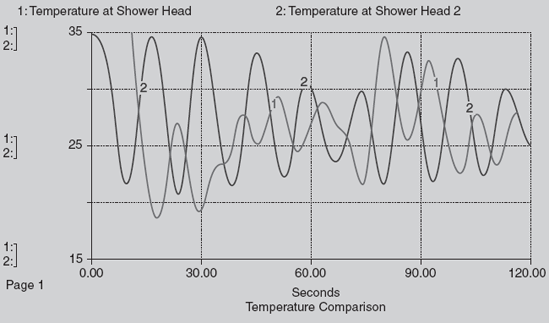4.4. Simulations of World of Showers B
Figure 4.11 shows typical simulated behaviour of temperature at the two shower heads over a period of two minutes (120 seconds). Shower-takers both begin too hot and inadvertently end up in an endless cycle of conflict and discomfort. Neither shower-taker is able to achieve a condition of stable and comfortable 25 °C water, despite the intention of both to do so. Instead of converging, the water temperature in both showers exhibits persistent fluctuations, sometimes reaching peaks of almost 35 °C and troughs of less than 20 °C. The strong coupling of the shower worlds is evident in the way temperature movements mirror each other – when the temperature is high in your shower (line 1), it is low in shower 2 (line 2), and vice versa.
Figure 4.11. Typical simulation of two interacting showers in World of Showers B

Such a world is confusing and frustrating for decision makers. Well intentioned actions to stabilise temperature (and so increase comfort) have the perverse effect of inducing instability. Moreover, no amount of time spent changing the tap setting will improve the situation. Each shower-taker adopts an adjustment strategy and mindset appropriate to a single shower, reinforced by visual cues that confirm they are in a single shower world – separate cubicles, a single tap to adjust, no awareness of the other shower or its occupant (just ...
Get Strategic Modelling and Business Dynamics: A Feedback Systems Approach now with the O’Reilly learning platform.
O’Reilly members experience books, live events, courses curated by job role, and more from O’Reilly and nearly 200 top publishers.

